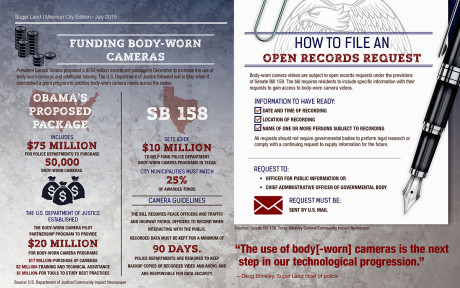State Rep. Ron Reynolds, D-Missouri City, co-sponsored a bill approved June 19 that establishes guidelines and a funding mechanism for police departments across the state to implement or advance body-worn camera programs.
Senate Bill 158 sets aside $10 million of the state’s general revenue for police departments to apply for funding for body-worn camera programs. The bill also requires police departments to adopt policies addressing camera usage, video storage and maintenance.
As the first comprehensive body-worn camera legislation in Texas, SB 158 gives police departments the discretion to adopt policies tailored to their respective communities. State Sen. Royce West, D-Dallas, who authored the bill, said he did not want to establish statewide mandates in an effort to provide each police department the freedom to determine which methods are most effective.
“Each community is different in the state of Texas, and for me to try and dictate to every community when they should have cameras turned on or off is not very feasible,” West said.
Reynolds said the bill is also intended to strengthen the relationship between police officers and the communities they serve.
Missouri City Police Chief Mike Berezin praised SB 158 for providing a framework for police departments to improve transparency and ensure officer and resident safety.
“You have to be able to trust at some point the police officer’s best interests are at heart anytime he comes in contact with the public,” Berezin said. “When we want to take discretion away from the officer in the field because you think the officer in the field is going to be more apt to do the wrong thing is when we have done something terribly wrong when creating trust with our community.”
Local programs
 Sources: Sugar Land Police Depar[/caption]
Sources: Sugar Land Police Depar[/caption]
The Sugar Land and Missouri City police departments are already in the process of establishing departmentwide body-worn camera programs.
The Sugar Land Police Department has outfitted 63 of its officers with Taser Axon body-worn cameras since November in an effort to strengthen its investigative resources, Sugar Land Police Chief Doug Brinkley said.
Although SB 158 establishes a funding mechanism for police departments to apply for state funding, SLPD already applied for $34,452 of grant funds through the Criminal Justice Division of the Texas Governor’s office in February. If awarded, SLPD will purchase 30 additional cameras, which will be used to outfit patrol supervisors and special unit officers, Brinkley said.
Brinkley said the addition of body-worn cameras has helped SLPD address resident concerns with regard to officer conduct and has also helped expand the department’s technological footprint.
[polldaddy poll=8971885]
“The use of body[-worn] cameras is the next step in our technological progression,” Brinkley said. “The body[-worn] cameras have been used as an investigative tool by capturing crime scene information at several calls for service by our officers and [have] been useful in responding to citizen complaints regarding officer conduct.”
MCPD applied for a two-year, $250,000 federal grant through the U.S. Department of Justice in June to fund initial startup costs for a 70-unit body camera program, according to city documents. The grant awards $125,000 in 2016 and 2017 and requires Missouri City to provide matching funds of $62,500 each year.
MCPD is seeking additional funding to cover the remaining funds needed for an initial five-year departmentwide program. MCPD officials did not indicate whether or not the department would apply for additional funding made available by SB 158.
Although MCPD wrapped up its 90-day body-worn camera pilot program with Taser—a law enforcement technology company—in June, Berezin said MCPD plans to test other body camera options from Fort Bend County-based Coban Technologies later this year.
Once MCPD establishes its program, Berezin said body-worn cameras would provide a third-person perspective during interactions with the community.
“I think we need the body[-worn] camera program so when we do something right, and get accused of something wrong, we can show we were doing it right [all along],” he said.
Berezin said the guidelines in SB 158 are just the first steps in strengthening and rebuilding trust between police departments and their respective communities. Berezin said he appreciates the freedom SB 158 gives local police departments and state law enforcement agencies to further develop body-worn camera policies.
“[SB 158] is mostly guidelines instead of mandates throughout the bill, [which] allows policies to be developed by the Texas Police Chiefs Association, the International Association of Chiefs of Police and by the local governing authority,” Berezin said.
Origin of SB 158

Reynolds said multiple national events, such as the fatal shooting of an unarmed teenager in Ferguson, Missouri, led state legislators to collaborate with various law enforcement entities to develop SB 158.
In addition major state police departments and civil rights organizations, such as the American Civil Liberties Union and the NAACP, were involved in workshops during the legislative session to address privacy, cost and video retention concerns, Reynolds said.
“We all came together over several months to hash out different issues,” Reynolds said. “Our goal was almost a pilot program to allow rollout, and we believe once the police departments see how beneficial [body-worn cameras] are, then more and more police departments will get the cameras.”
The collaborations resulted in guidelines similar to another bill authored by West in 2001—SB 1074—by requiring video recorded by body-worn cameras and dashboard cameras to be held for a minimum of 90 days.
West said he used SB 1074 as a benchmark for SB 158. As a result, police departments are allowed to integrate body-worn camera policies with established dashboard camera policies.
Reynolds said he is optimistic SB 158 will result in departments utilizing body-worn cameras as much as dashboard cameras have been used in the past.
“Every police car has a dash[board] camera, and eventually every police officer will have a body[-worn] camera,” he said. “You cannot have this barrier where people feel anything can happen because there is no recording.”




